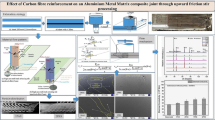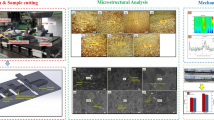Abstract
Aluminium alloys has been favoured in many applications because of its exciting properties which include light weight and corrosion resistance. However, susceptibility to pitting corrosion and intergranular corrosion (IGC) are some of the drawbacks of aluminium. The surface of aluminium can be modified to improve its corrosion resistance properties. Surface modification is a surface engineering process that is performed to alter the properties of material surface to improve its service life. Friction stir processing (FSP) is a relatively new and an important solid state material surface modification process. In this study, investigation on the influence of FSP processing parameters on the resulting corrosion resistance surface properties of pure commercial aluminium and Ni-40Fe-10Ti surface composite using friction stir processing technique was conducted. The processing parameters that were studied are tool rotational speed and transverse speed, while all other processing parameters were kept constant. The corrosion behaviour was studied using three-electrode electrochemical cell, and the microstructure of the corroded samples was studied using optical microscope (OM). The results showed that the addition of Ni, Fe and Ti caused a decrease in the anodic and cathodic current densities. The set of processing parameters that resulted in the lowest corrosion rate are the rotational speed of 600 rpm and transverse speed of 70 mm/min.










Similar content being viewed by others
Data availability
N/A
References
Fuller CB, Mahoney MW, Calabrese M, Micona L (2010) Evolution of microstructure and mechanical properties in naturally aged 7050 and 7075 Al friction stir welds. Mater Sci Eng A 527:2233–2240
Harrison TJ, Crawford BR, Brandt M, Clark G (2014) Modelling the effects of intergranular corrosion around a fastener hole in 7075-T651 aluminium alloy. Comput Mater Sci 84:74–82
Jones K, Hoeppner DW (2009) The interaction between pitting corrosion, grain boundaries, and constituent particles during corrosion fatigue of 7075-T6 aluminium alloy. Int J Fatigue 31(2009):686–692
Fraker AC, Ruff AW Jr (1970) Microstructural studies of 7075 Al relation to the directional sensitivity for stress corrosion cracking. Corros Sci 10:191–195
Xu J, Zou B, Tao S, Zhang M, Cao X (2016) Fabrication and properties of Al2O3eTiB2eTiC/Al metal matrix composite coatings by atmospheric plasma spraying of SHS powders. J Alloys Compd 672:251–259
Akinlabi ET, Mahamood RM Akinlabi SA, Ogunmuyiwa E (2014) Processing parameters influence on wear resistance behaviour of friction stir processed Al-TiC composites advances in materials science and engineering. Available online at: https://doi.org/10.1155/2014/724590
Akinlabi ET, Mahamood RM, Akinlabi SA (2016) Advanced manufacturing techniques using laser material processing. IGI Global, Hershey
Akinlabi ET, Mahamood RM (2020) Solid-state welding: friction and friction stir welding processes. Springer, Cham
Mishra RS, Mahoney MW, McFadden SX, Mara NA, Mukherjee AK (2000) Scripta Mater 42:163–168
Thomas WM, Nicholas D, Needham JC, Murch MG, Smith PT, Dawes CJ (1991) Friction stir welding, International Patent Appl. No. PCT/GB92/02203 and GB Patent Application No. 9125978.8 and US Patent Application No. 5,460,317.
Mahmoud TS (2013) Surface modification of A390 hypereutectic Al–Si cast alloys using friction stir processing. Surf Coat Technol 228:209–220
Li B, Shen Y, Hu W, Luo L (2014) Surface modification of Ti–6Al–4V alloy via friction-stir processing: microstructure and dry sliding wear performance. Surf Coat Technol 239:160–170
Ma ZY (2008) Friction stir processing technology: a review. Metall Mater Trans A 39A:642–658
Chiumenti M, Cervera M, Agelet de Saracibar C, Dialami N (2013) Numerical modeling of frictional stir welding processes. Comput Methods Appl Mech Eng 254:353–369
Balyanov A, Kutnyakova J, Amirkhanova N, Stolyarov V, Valiev R, Liao X, Zhao Y, Jiang Y, Xu H, Lowe T (2004) Corrosion resistance of ultra fine-grained Ti. Scr Mater 51:225–229
Argade G, Panigrahi S, Mishra R (2012) Effects of grain size on the corrosion resistance of wrought magnesium alloys containing neodymium. Corros Sci 58:145–151
Gharavia F, Matoria KA, Yunusa R, Othman NK (2014) Investigation of the nugget zone corrosion behavior in friction stir welded lap joints of 6061-T6. Aluminum Alloy 17(6):1563–1574
Sinhmar S, Dwivedi DK (2017) Enhancement of mechanical properties and corrosion resistance of friction stir welded joint of AA2014 using water cooling. Mater Sci Eng A 684(2017):413–422
Zahmatkesh B, Enayati MH (2010) A novel approach for development of surface nanocomposite by friction stir processing. Mater Sci Eng A 527:6734–6740
Shamsipur A, Kashani-Bozorg SF, Zarei-Hanzaki A (2011) The effects of friction-stir process parameters on the fabrication of Ti/SiC nano-composite surface layer. Surf Coat Tech 206:1372–1381
Acknowledgements
The authors acknowledge the provision of research facilities used in this work by the Department of Chemical, Metallurgy and Materials Science Engineering of Tshwane University of Technology. This research study is part of the joint research undertaken by a consortium of researchers from Tshwane University Technology, University of Johannesburg, Walter Sisulu University and the University of Leicester, United Kingdom, under the Industry Academic Partnership Programme (IAPP) sponsored by the Royal Academy of Engineering, United Kingdom. The content of this paper are that of the author and co-authors and not that of the sponsors of the research project.
Funding
This research was supported by the National Research Foundation (NRF) of South Africa.
Author information
Authors and Affiliations
Corresponding author
Ethics declarations
This article is in compliance with ethical standard.
Conflict of interest
The authors declare that they have no conflicts of interest.
Consent for publication
I hereby declare that this manuscript has not been published, and it is not under consideration in any journal.
Code availability
N/A
Additional information
Publisher’s note
Springer Nature remains neutral with regard to jurisdictional claims in published maps and institutional affiliations.
Rights and permissions
About this article
Cite this article
Sibisi, T.H., Shongwe, M.B., Johnson, O.T. et al. Effect of processing parameters on corrosion behaviour of Al reinforced with Ni-40Fe-10Ti alloy fabricated by FSP. Int J Adv Manuf Technol 110, 2703–2711 (2020). https://doi.org/10.1007/s00170-020-06031-0
Received:
Accepted:
Published:
Issue Date:
DOI: https://doi.org/10.1007/s00170-020-06031-0




